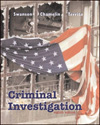1
A) Advanced B) Cold C) Collateral D) Follow-up 2
A) essential part of police work. B) follow-up investigation. C) Cold search. D) Preliminary investigation. 3
A) The ability to utilize deadly force in making an arrest B) The ability to converse equally well with a wide range of people C) Good luck D) A narrow range of contacts 4
A) It may go undetected.
Incorrect: This describes only one possible outcome. B) If a violation is reported, it may not be detected. C) The crime may come to the attention of the police through their observation or a complaint by a victim or a witness. D) All of the above. 5
A) Note all dispatch information carefully. B) Be alert for people and cars leaving the crime scene. C) Approach the scene cautiously, scan the entire area thoroughly, assess the scene, be aware of people and vehicles in the vicinity that may be related to the call. D) In assessing the scene, apply all of your senses, be alert for dangers, let other responders know of dangers and request specialized help as the situation dictates. 6
A) Note all dispatch information carefully. B) Be alert for people and cars leaving the crime scene. C) Approach the scene cautiously, scan the entire are thoroughly, assess the scene, be aware of people and vehicles in the vicinity that may be related to the call. D) In assessing the scene, apply all of your senses, be alert for dangers, let other responders know of dangers and request specialized help as the situation dictates. 7
A) Note all dispatch information carefully. B) Be alert for people and cars leaving the crime scene. C) Approach the scene cautiously, scan the entire are thoroughly, assess the scene, be aware of people and vehicles in the vicinity that may be related to the call. D) In assessing the scene, apply all of your senses, be alert for dangers, let other responders know of dangers and request specialized help as the situation dictates. 8
A) Note all dispatch information carefully. B) Be alert for people and cars leaving the crime scene. C) Approach the scene cautiously, scan the entire are thoroughly, assess the scene, be aware of people and vehicles in the vicinity that may be related to the call. D) In assessing the scene, apply all of your senses, be alert for dangers, let other responders know of dangers and request specialized help as the situation dictates. 9
A) Receipt of information and initial response B) Emergency care C) Crime scene control D) Preparation of the incident/offense report 10
A) The third step in a preliminary investigation. B) The sixth step in a preliminary investigation. C) The fourth step in a preliminary investigation. D) Prepare the incident/offense report. 11
A) Macroscopic B) Microscopic C) Secondary D) Primary 12
A) Burglary B) Murder C) Forcible rape D) Motor vehicle theft 13
A) Reconstructing what happened. B) Developing an incident/offense report. C) Technical services D) Coordinating the autopsy 14
A) Reconstructing what happened. B) Developing an incident/offense report. C) Technical services D) Coordinating the autopsy 15
A) Video recorder B) Portable copier/printer C) Tweezers and forceps D) Crime scene barrier tape 16
A) Video recorder B) Portable copier/printer C) Tweezers and forceps D) Crime scene barrier tape 17
A) Video recorder B) Portable copier/printer C) Tweezers and forceps D) Crime scene barrier tape 18
A) Maintenance of control B) Photographing the entire scene C) Inclusiveness of only major evidence D) Preparation of the administrative log 19
not a typical threat to the health and safety of criminal investigators?A) Insect stings B) Infectious pathogens C) Common cold D) Chemicals 20
not an indication of suspicious mail according to the Centers for Disease Control?A) Proper postage B) Excessive packaging material such as masking tape or string C) Marked with restrictions D) Not addressed to a specific person 21
A) Lack of insects B) Discoloration of plants C) Vapor, mist, thin fog, or low clouds unrelated to the weather. D) Snowfall 22
A) Coordination B) Boundary determination C) Utilizing personal protective equipment D) Care and collection of evidence 23
A) Images can be viewed immediately. B) The stored images are subject to electromagnetic degrading. C) The storage media are easy to obtain. D) It is easy to pull up old, archived images. 24
not a guideline for photographing almost any crime scene?A) Keep a photo log of all shots taken. B) If in a building, take pictures of all doors and exits. C) Document all stages of the investigation, including physical evidence discoveries. D) Photograph the scene a few days after the crime scene is discovered. 25
A) The submitting person’s agency, address, and phone number B) Case identification numbers, the nature of the evidence submitted, and all communications relating to them C) Description of the nature of the offense and the basic facts related to it D) None of the above.



 2002 McGraw-Hill Higher Education
2002 McGraw-Hill Higher Education